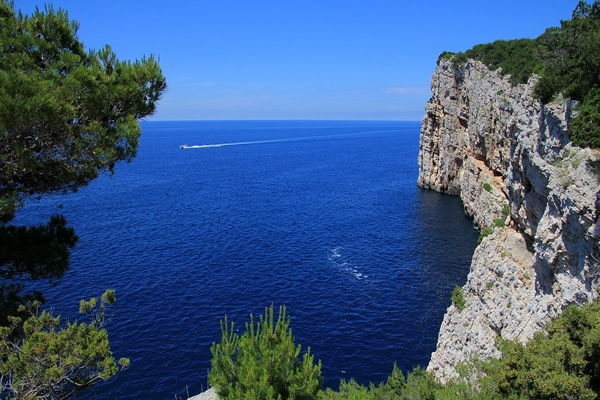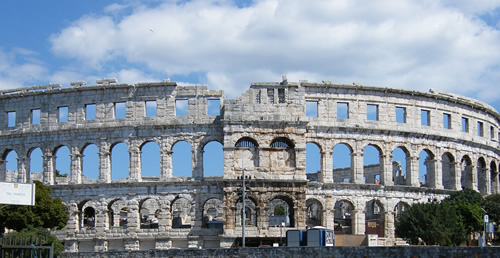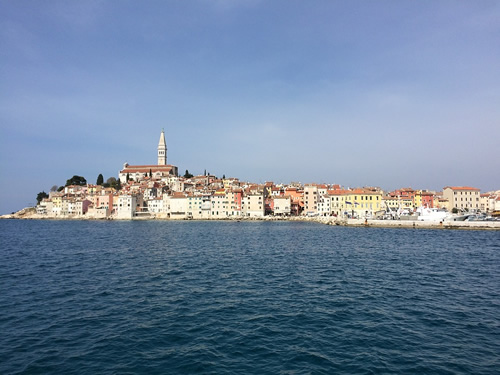Budget Travel on Croatia’s Coast
Between the Mountains and the Sea
By Volker Poelzl

|
|
Much of Croatia's coast consists in spectacular cliffs.
|
Croatia is not exactly a hidden travel destination, given its 20+ million annual visitors. Still, for many North Americans, the small Adriatic country remains off the beaten path and relatively unknown. Although popular with tourists from Central Europe in the summer, Croatia's magnificent coastline is quiet in spring and fall, providing an affordable and enjoyable vacation spot without the crowds. Despite its small size, Croatia offers many natural, cultural, and historic attractions, all on a relatively narrow strip of land along the Adriatic Sea. The country has towering mountain ranges, a magnificent coastline, beautiful island archipelagos, and many cultural gems from Europe's past. Within an hour's drive, you can scale tall limestone walls in the Velebit Mountains, visit the remains of Croatia's medieval kingdom, go kite surfing in a windswept bay, and sip coffee on a square that was once a Roman marketplace.
Finally, for the budget-conscious traveler,
Croatia remains cheaper than many European travel destinations. Transportation, lodging, and food costs are still lower than in much of Central and Western Europe.
Croatia: A Land Rich in History and Art
A visit to Croatia allows visitors to explore the Croatian people's unique culture. It offers a glimpse into the history of its invading neighbors. Croatia's history is closely linked to that of Central European powers, which left their cultural and architectural heritage. Not only did the Greeks and Romans leave their traces here, but there are also historic remains of early Christian churches, medieval castles, and Venetian palaces, which tell the turbulent history of a region torn between its allegiance to Eastern and Central European powers. The importance of Croatia's historic places has also been recognized by UNESCO, including several sites on its World Heritage list, such as landmark sites such as Sibenik, Split, Trogir, and Dubrovnik, all situated on the Adriatic Sea.
As mentioned above, visitors can take a trip through much of Croatia's history within a short distance along the Adriatic Sea. The city of Zadar, for example, situated along Croatia's central coast, has a well-preserved Roman Forum, a 9th-century Romanesque basilica, and Renaissance architecture from when the city was under Venetian rule. The many new buildings in the old town bear testimony of the rebuilding efforts following Zadar's siege by Serbian forces during Croatia's war of independence from 1991-95. The image that emerges from this mosaic of history is that of a young nation proud of the diverse heritage that it shares with other European countries.

|
|
Ancient Roman monuments, including forums, can be found in Croatia.
|
Croatia: A Great Destination for Outdoors Enthusiasts
Mostly known for its seaside vacation resorts, the country has much more to offer than the warm waters of the Adriatic Sea. In addition to its beautiful coastline with innumerable islands, cliffs, bays, and inlets, Croatia is home to rugged mountain ranges, narrow gorges, caves, and pristine lakes and waterfalls. The natural feature that most characterizes Croatia's landscape is karst rock. This porous limestone makes up most of the country's mountains and islands. Since water quickly drains through the karst rock, vegetation is scarce. Soil quality is poor throughout the karst region, which is why much of the coastal Velebit mountain range and the adjacent island archipelagos have only been sparsely settled and cultivated throughout the region's history. But what was once an obstacle to Croatia's human development has become one of the main assets of its tourism industry today. The barren beauty of the karst rock gives the Croatian landscape its unique flair, with its white rock faces, narrow gorges, deep caves, massive waterfalls, and a maze of uninhabited islands just offshore. In recognition of its natural beauty and cultural significance, the arid and rocky Kornati Archipelago along Croatia's central coast has been declared a national park, prohibiting the development of any tourism infrastructure on the islands. Today, it is one of the largest marine and island reserves in the Mediterranean and teems with marine and avian wildlife. Day trips to the national park are offered from nearby coastal towns such as Zadar and Murter.
The Velebit mountains that run parallel to the coast offer some of Croatia's most spectacular scenery and various outdoor activities. Although the mountain range is not the highest in Croatia, its rugged and sparsely populated terrain makes for great hiking, trekking, caving, and rock climbing. Paklenica National Park, near the historic coastal town of Zadar, is the outdoor recreation center in this mountainous region. The narrow gorge at the park entrance offers excellent rock climbing routes, and the backcountry has many hiking trails and several huts where hikers can spend the night.
Krka National Park is another worthwhile natural attraction near the coast. Located 30 miles inland from the picturesque historic town of Sibenik, the park is best known for its magnificent waterfalls created by the river Krka. Although the park does not have a network of long hiking trails as does the nearby Paklenica National Park, there are several shorter trails and boat excursions that take visitors through a long gorge past waterfalls. Not to mention a secluded island monastery.
In addition to visiting Croatia's national parks, visitors can indulge in various outdoor activities along the coast. Swimming, boating, and sailing are naturally the most popular activities here. Nonetheless, with its many inlets and adjacent mountains, the rugged coast provides excellent conditions for more demanding sports such as kitesurfing and windsurfing. The pristine maritime ecosystem of Kornati National Park is also a fantastic destination for divers.

|
|
One of Croatia's many islands, some inhabited, some not.
|
Budget Accommodations
Except for large hotels located around the Istrian peninsula in the north, accommodations along Croatia's coast are provided mainly by affordable small hotels, pensions, and guest houses. Traveling by car, you can also take advantage of the many campgrounds scattered along Croatia's Adriatic coast.
Getting To and Around Croatia
Regular flights to Croatia's capital, Zagreb, exist from many European airports. During the summer, charter airlines offer additional flights that connect major European cities to Croatian vacation destinations along the coast, such as Pula, Zadar, Split, and Dubrovnik. Try Croatia Airlines or RyanAir.
Five cities along the Adriatic coast can be reached by train: Pula and Rijeka in the north, Zadar Sibenik and Split along the Central Dalmatian coast. Croatia is part of the Eurail Pass system, meaning you can travel to Croatia on a Eurail Pass, a regional pass, or a Croatia Rail Pass.
There is regular ferry service from several northern Croatian cities to Venice, as well as from Zadar, Split, and Stari Grad to Ancona (Italy) and from Split to Pescara (Italy). Some ferries run up and down the Croatian coast from Dubrovnik to Rijeka. In addition, there is a regular ferry service connects all populated islands in Croatia with the mainland. Small cruise ship and sailing options are also available for those looking for a bit more luxury.
Buses operate between larger cities as well as smaller towns. Bus and train travel should get you around Croatia without problems if you don't have a car. Bus Croatia provides schedules that allow you to book tickets inside Croatia and connect to several other European countries.
All major international car rental companies have branches in Croatia, mostly at airports and towns along the Adriatic Sea.
When to Go
As elsewhere in Europe, summers are the most crowded and expensive season to travel in Croatia. On the other hand, this is also when most of the art, culture, and music festivals occur if that's one of your main interests. But Croatia is also an ideal destination for off-season travel with fewer tourists and lower prices. Due to its southern location, Croatia's Adriatic coast has a mild Mediterranean climate, with long, hot summers and short, rainy winters. Spring and fall are great seasons for a visit to Croatia. The weather is warm, and even though water temperatures are slightly lower than in the summer, plenty of outdoor and cultural activities still suit your interests.
Volker Poelzl is a Living Abroad Contributing Editor for Transitions Abroad.
|
